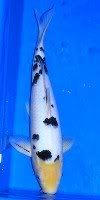
Pic.1. Shiro Bekko
The preferred quality of sumi in Bekko is the same as those in Sanke, i.e., arranged like a set of stepping stones in a garden. There has to be a moderate number of sumi markings to help create the Bekko’s appearance of being neat, tidy, and elegant. Because of the simplicity of the coloring and pattern, the criteria in selecting for quality are quite severe.Shiro Bekko should have a true white base, without any yellowing. Unfortunately, a common problem for Shiro Bekko is the development of a yellow head.When selecting a young Bekko, not a single hi marking (however faint) is permissible. Also avoid any young Aka Bekko or Ki Bekko with the slightest indication of small white markings or breaks on the ground of red or yellow. In small Bekko, the sumi markings might not have full luster and might even still be “submerged.”Where the sumi is still submerged, it will appear bluish.
Select youngsters with well defined sumi markings arranged along the length of the body. Bear in mind that the sumi markings of the young Bekko will have to remain substantial enough in size and arrangement when it has grown big. If the size and pattern of the markings are insipid in a young Bekko (regardless of their quality), the Bekko will have an even more insipid appearance when it is an adult. It should be immediately apparent that the sumi markings, viewed individually, will be strong, but also that the pattern of those markings will nevertheless be elegant. Too much Tejima, or ojima (stripes in the tail) are not attractive. If they appear boldin a young Bekko, they might gain the desired definition later on, but this can never be guaranteed.
Source:
1. Selecting Young Bekko,BobWinkler, AKCA Certified Judge, Colorado.